Phish Bassist Mike Gordon Tells New England Post About Another Side of In
Posted by Soren Sorensen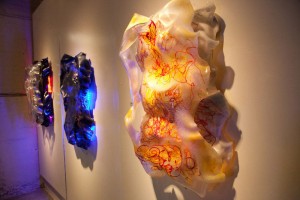 If you’ve ever listened to Mike Gordon’s 2003 album Inside In, you’ve probably never thought to yourself, “This music would be perfect for an interactive multimedia installation.”
If you’ve ever listened to Mike Gordon’s 2003 album Inside In, you’ve probably never thought to yourself, “This music would be perfect for an interactive multimedia installation.”
While most of the folky, psychedelic self-consciousness that Phish’s bassist summons is well worth revisiting when you’re in the right frame of mind, the funky 70s grooves and throwback slow jams will likely not remind listeners of art museums, galleries or the paint-splattered loft spaces of Velvet Underground’s New York.
Still, with guest appearances by Béla Fleck, Vassar Clements and Col. Bruce Hampton (ret.), among others, it’s a memorable listen.
Inside In is a fulcrum of sorts; one point of a three-work constellation. The other two are Outside Out, Gordon’s 2001 full-length feature film, and Another Side of In, a collaboration between Gordon, artist Margorie Minkin (Mike’s mom) and electronics engineer Jamie Robertson.
Another Side of In is made up of Minkin’s painted Lexan sculptures, sounds from Inside In Gordon lifted and looped specifically for the piece, light and perhaps most importantly, the intervention of a willing participant.
The latest exhibition of the piece will be at the Charles River Museum of Industry and Innovation through December 23. Mike Gordon’s been a busy man lately—Phish’s recent benefit concert raised $1.2 million for Vermont residents affected by Tropical Storm Irene. But he was nice enough to answer a few questions from New England Post about the Another Side of In.
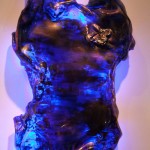 NEP: With the interactivity of an installation like Another Side of In, pictures, recordings, even videos, don’t really do much to explain the experience. How would you describe the work to someone who’s never experienced an interactive multimedia art installation?
NEP: With the interactivity of an installation like Another Side of In, pictures, recordings, even videos, don’t really do much to explain the experience. How would you describe the work to someone who’s never experienced an interactive multimedia art installation?
MG: Interactive means that you are making a friend with the piece of art. You’re relating to it as if it’s another living creature, it reacting to your movements. My mother’s torso shapes make that easy to imagine, whereas the sounds provide a more abstract kind of character for those new friends.
NEP: Originally, if I’m not mistaken, there were 20 individual painted Lexan sculptures accompanied, with the presence and movement of spectators, by sounds and light. What was the process behind selecting and placing portions of the work for exhibition, five pieces in the case of the Charles River Museum version?
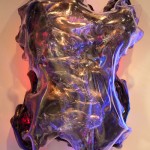 MG: My mother chose the five pieces, based on providing a variety of visual and auditory experiences, and ones that can blend together nicely when activated. There is something nice about a small exhibit, since you get to know each one more intimately. It’s like playing music in an arena versus a club… both approaches have cool aspects.
MG: My mother chose the five pieces, based on providing a variety of visual and auditory experiences, and ones that can blend together nicely when activated. There is something nice about a small exhibit, since you get to know each one more intimately. It’s like playing music in an arena versus a club… both approaches have cool aspects.
NEP: For those unfamiliar with your 2001 film Outside Out and 2003 companion album Inside In, how would you describe their relationship? Was the record a collection of ideas, snippets and fragments of unfinished songs from a period of many years or did you sit down, decide to make a record, write it and record it?
MG: I had recorded all of the soundtrack for the movie myself, including the sound effects, music, production sounds, and ambiences. It was particularly cool to mix and match the roles of those categories—like using the sound of a washing machine as a song texture. I took the background sounds and score music and created the album from the movie. This involved spending a few months with film music, adding lyrics and song structures that would stand alone. The original tracks were used, with new parts overdubbed.
NEP: Another Side of In includes looped portions of sounds culled from the record. I know some artists feel like projects are never finished, they’re just abandoned. Was it fun to get under the hood of that record again? To what extent did you know exactly where to find the sounds that might best compliment Another Side of In?
MG: The nice thing is that some creative fun goes into sound design for movies, and for albums, but in this case the backgroundy textures that one might not be conscious of hearing are given the spotlight. There were considerations about finding sounds that would mix together—some more ambient, some more rhythmic, etc., and searching for the kind of abstraction in sound that would allow each piece to grow into it’s own character. My mother listened to each sound for the time she was working on the piece that would accompany it, and as the collection came into fruition, we discussed what we needed more or less of.
NEP: Your mother, Marjorie Minkin, created the painted Lexan sculptures in the exhibit. In your artist’s statement, you say your artistry has always been inspired by your mother’s. Can you describe how?
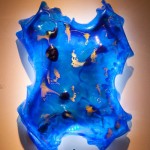 MG: We had a neighbor who used the expression, “anything within limitations,” and my mother said she hated that concept—that limits are to be pulled and stretched. I was inspired how she would find a new medium or approach and then spend a decade or so trying countless variations on a theme, stretching every limit possible, from colors to opacity to layers. I was always so proud that the concept of mom to me was a woman in a room with several hundred gallons of iridescent paint and twenty foot canvases, or warped layerings of plastic.
MG: We had a neighbor who used the expression, “anything within limitations,” and my mother said she hated that concept—that limits are to be pulled and stretched. I was inspired how she would find a new medium or approach and then spend a decade or so trying countless variations on a theme, stretching every limit possible, from colors to opacity to layers. I was always so proud that the concept of mom to me was a woman in a room with several hundred gallons of iridescent paint and twenty foot canvases, or warped layerings of plastic.
NEP: I think people tend to dismiss work like this, interactive multimedia installations, without having an understanding the history of conceptual art. I’m thinking of Marcel Duchamp who began to work with ideas like interactivity, mixed media, recycling found objects, etc. about 100 years ago. Growing up around your artist mother, you must’ve been aware of conceptual art in a way most children are not. Does the work of specific conceptual artists inform Another Side of In or does the work flow simply from a place of open-minded creativity?
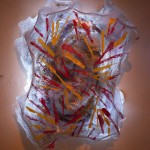 MG: For some reason, I fantasized about multisensory installations and spaces my whole life. I wanted to build an enclosed room with prerecorded media that would appeal to all the senses at once since being a young child. Growing older, I refined my tastes and grew to love abstraction, and the kind of simplicity art like this can have. I’ve also been involved in many kinds of interactive experiments in the live music setting, so making art interactive appealed to me. What didn’t appeal to me is a lot of the interactive shows I saw when I started researching the field—especially when there is a latency that makes the experience feel disconnected. You have to feel like you are directly causing something to happen immediately, and if you do, it’s a cool feeling.
MG: For some reason, I fantasized about multisensory installations and spaces my whole life. I wanted to build an enclosed room with prerecorded media that would appeal to all the senses at once since being a young child. Growing older, I refined my tastes and grew to love abstraction, and the kind of simplicity art like this can have. I’ve also been involved in many kinds of interactive experiments in the live music setting, so making art interactive appealed to me. What didn’t appeal to me is a lot of the interactive shows I saw when I started researching the field—especially when there is a latency that makes the experience feel disconnected. You have to feel like you are directly causing something to happen immediately, and if you do, it’s a cool feeling.
NEP: Why do you think practitioners of some styles of art, music, dance, etc. seem to have no shelf life, while others struggle to gain traction outside of very small, cliquey communities? Do you think technology (Internet, smartphones, etc.) is changing this?
MG: We couldn’t have predicted that Phish would have become so successful, and it would take volumes for me to attempt to guess why, though I have some guesses. One could read “The Tipping Point,” by Malcolm Gladwell for a dabbling into the subject of why some things get popular. I’m sure new technology will both change the way art is created and the way it’s experienced, and things are getting more interactive with touch screens and online schools. Creative people are having a field day, regardless of which ones become popular.
NEP: Phish just played its first show in Vermont in a long time, a benefit for Tropical Storm Irene victims. How are things in Vermont at the moment and what can/should people do if they want to help?
MG: Even assessing the damage will take a while, never mind all the mending. People can donate through phish.com by finding links to our Waterwheel Foundation, and volunteers are needed to help at cleanup sites.
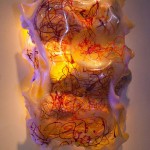 NEP: What are you working on now? Are there any other mother/son collaborations on the horizon?
NEP: What are you working on now? Are there any other mother/son collaborations on the horizon?
MG: I have fantasies for some intense variations and enhancements of our show. ASOI v. 9.2? I’m currently working on some music writing and recording projects, with various people, and for various outlets. I’m also looking forward to my next film project when the time is right.
Another Side of In will be at the Charles River Museum of Industry and Innovation through December 23. Thanks to Jon Fischer Photography for the images and video.
Related posts:
- Phish Show Raises More Than $1.2M for Vt. Recovery
- Rhode Islanders Not Surprised By Charges Against Rep. Daniel Gordon Jr.
- New Short Film From Derek Dubois At 13th Annual Pawtucket Film Festival This Weekend
Short URL: http://www.newenglandpost.com/?p=4759








